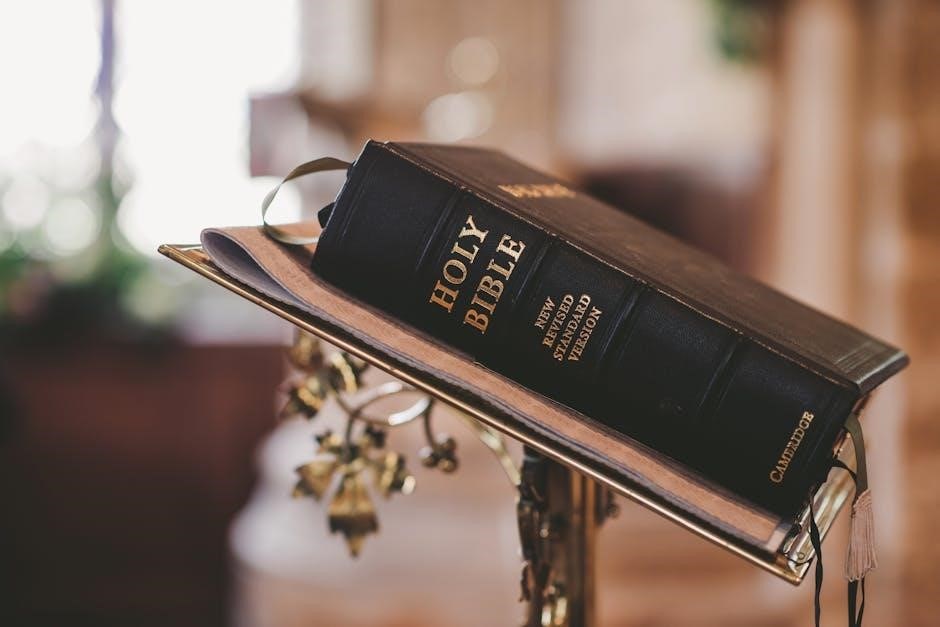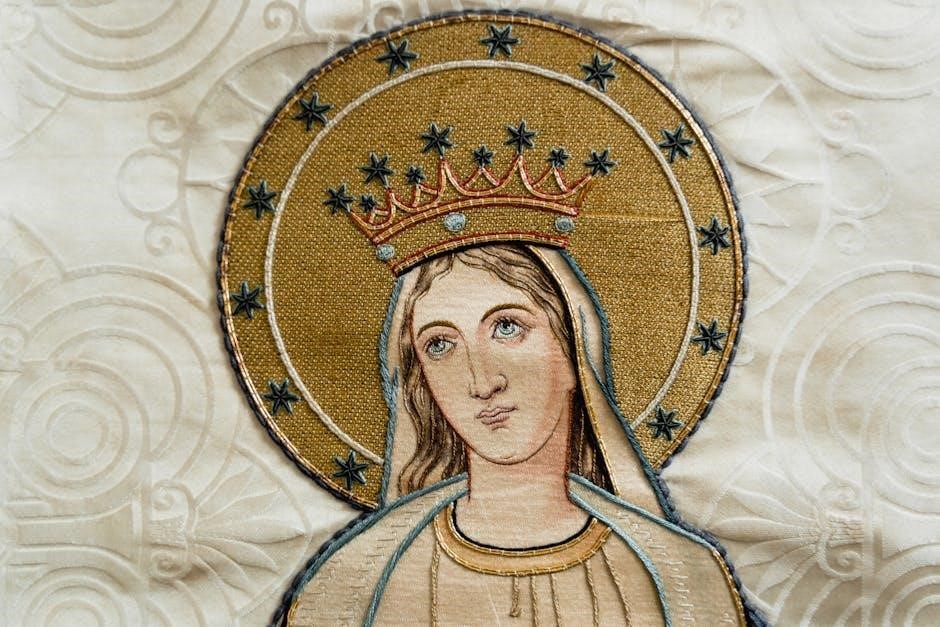Biblical symbols are powerful tools for deeper spiritual understanding, offering insights into complex theological concepts through imagery and metaphor. Exploring these symbols, as outlined in various Bible study resources like PDF guides, reveals their profound significance in both Old and New Testaments, enriching one’s faith journey and fostering a more meaningful connection with Scripture.
1.1. Overview of Biblical Symbolism
Biblical symbolism is a rich and complex system of images, colors, and objects that convey deeper spiritual truths. Symbols like fire, water, and bread are recurring motifs that resonate across both testaments. For instance, fire symbolizes purification and the Holy Spirit, while water represents cleansing and baptism. These symbols often carry multiple layers of meaning, reflecting cultural, historical, and theological contexts. Understanding them requires exploring their usage in specific passages and their connections to broader themes. Resources such as Bible study guides and PDF materials provide valuable insights, helping readers decipher these symbols and apply their meanings to modern spiritual life.
1.2. Importance of Understanding Symbols in the Bible
Understanding Bible symbols is crucial for grasping the deeper spiritual truths embedded in Scripture. Symbols serve as powerful tools for conveying complex theological concepts, making abstract ideas relatable through familiar imagery. For example, fire represents purification and the Holy Spirit, while water symbolizes cleansing and baptism. These symbols often carry multiple layers of meaning, reflecting cultural, historical, and theological contexts. By studying them, readers can gain a richer understanding of God’s message and its application to daily life. Resources such as Bible study guides and PDF materials provide valuable insights, helping believers decipher these symbols and deepen their spiritual connection to the Word of God.
1.3. Common Sources for Bible Symbol Meanings
Understanding Bible symbols often requires consulting reliable sources, such as commentaries, dictionaries, and study guides. PDF resources, like “Bible Symbols and Meanings,” offer comprehensive explanations, linking symbols to their scriptural contexts. Online Bible studies and tools, such as YouVersion, also provide insights into symbolic meanings. Additionally, theological books and scholarly articles delve into the cultural and historical backgrounds of these symbols, enhancing comprehension. Fire, for instance, symbolizes purification and the Holy Spirit, while water represents cleansing and baptism. These sources help believers decode the rich imagery in Scripture, fostering a deeper connection to its teachings and spiritual significance.

Key Symbols in the Bible and Their Interpretations
The Bible is rich with symbols like fire, water, and bread, each carrying deep spiritual meanings. These symbols, explored in resources like “Bible Symbols and Meanings PDF,” offer insights into divine truths, connecting believers to God’s plan and redemption.
2.1. The Tree of Life: Symbolism in Genesis and Revelation
The Tree of Life is a profound symbol in the Bible, first appearing in Genesis as the source of eternal life in the Garden of Eden. It reappears in Revelation, symbolizing God’s restoration and eternal presence. In Genesis, the tree represents the divine life and wisdom Adam and Eve could have enjoyed. Its absence after the Fall signifies the loss of paradise. In Revelation, it stands in the New Jerusalem, bearing fruit for healing, symbolizing eternal life and fellowship with God. This imagery highlights God’s plan to restore humanity to His presence, bridging the beginning and end of His redemptive story.
2.2. The Lamb of God: Representation of Jesus Christ
The Lamb of God is a central symbol in the Bible, representing Jesus Christ as the ultimate sacrifice for humanity’s sin. In John 1:29, John the Baptist declares Jesus as the “Lamb of God who takes away the sin of the world.” This imagery draws from Old Testament sacrifices, where lambs were offered for atonement. Jesus, as the sinless Lamb, fulfilled this role once and for all through His crucifixion. The Lamb also symbolizes purity, humility, and redemption. In Revelation, Jesus is referred to as the Lamb who conquers, emphasizing His triumph and divine authority. This symbol underscores God’s love and the sacrificial nature of Jesus’ mission to restore humanity to God.
2.3. The Holy Spirit: Symbols Like Fire, Water, and Oil
The Holy Spirit is represented through various symbols in the Bible, each carrying profound spiritual significance. Fire symbolizes purification, empowerment, and God’s presence, as seen at Pentecost where tongues of fire rested on believers. Water represents cleansing and new life, as Jesus referred to the Holy Spirit as “living water” that quenches spiritual thirst. Oil, used in anointing, signifies consecration and empowerment, highlighting the Holy Spirit’s role in setting apart individuals for divine service. These symbols collectively illustrate the Holy Spirit’s transformative power, nurturing grace, and sanctifying work in the lives of believers.
2.4. The Bread of Life: Symbolism in the New Testament
In the New Testament, Jesus refers to Himself as the “Bread of Life,” symbolizing spiritual nourishment and eternal life. This imagery, rooted in Jewish tradition, reflects God’s provision, such as manna in the wilderness. Jesus extends this metaphor, declaring that believing in Him satisfies spiritual hunger forever. The bread also represents His sacrifice, as He gives His body for humanity’s salvation. In Communion, bread signifies unity with Christ and remembrance of His covenant. The Bread of Life embodies God’s sustenance, sacrifice, and the fulfillment of spiritual longing, urging believers to seek Jesus as their ultimate source of life and satisfaction.
2.5. Living Water: Its Spiritual Significance

In the Bible, “living water” is a profound symbol representing spiritual life and renewal. Jesus famously refers to Himself as the source of living water, promising eternal life to those who drink (John 4:14). This imagery contrasts physical water, which temporarily quenches thirst, with spiritual water that satisfies forever. Living water symbolizes the Holy Spirit, who flows from believers (John 7:38-39), bringing purification, renewal, and divine life. It also represents God’s Word and His presence, which refresh and transform. The concept underscores the necessity of spiritual hydration for a vibrant, God-centered life, emphasizing faith and dependence on Him as the ultimate source of true fulfillment and eternal life.

Colors in the Bible and Their Meanings
Colors in the Bible carry deep spiritual meanings, conveying messages about God’s nature, humanity, and divine plans. They enrich understanding of scriptural themes and symbols.
3.1. Red: Symbolism of Blood, Sacrifice, and Redemption
Red in the Bible is deeply tied to blood, sacrifice, and redemption. It signifies life, as life is in the blood (Leviticus 17:11), and represents atonement for sin. The blood of animals in Old Testament sacrifices prefigured Jesus Christ’s ultimate sacrifice, where His blood was shed for humanity’s redemption. Red also symbolizes covenant and forgiveness, as seen in the Passover, where the Israelites marked their doors with lamb’s blood to avoid judgment. This color underscores the profound spiritual truth of salvation through blood sacrifice, embodying God’s mercy and humanity’s reconciliation to Him.
3.2. Blue: Representation of Heaven and Holiness
Blue in the Bible symbolizes heaven, holiness, and divine authority. It is often linked to God’s throne and the celestial realm, as seen in descriptions of the heavens declaring God’s glory (Psalm 19:1). The use of blue dye, known as tekhelet, was highly valued and reserved for sacred purposes, such as the priestly garments (Exodus 28:5-6) and the tabernacle’s furnishings. Blue represents purity, moral integrity, and the divine presence. It also appears in the fringes of garments as a reminder to follow God’s commands (Numbers 15:38-40). This color underscores the transcendent and sacred nature of God’s kingdom and His holy standards.
3.3. Purple: Symbol of Royalty and Kingship
In the Bible, purple is a symbol of royalty, power, and wealth, often associated with kingship and divine authority. The production of purple dye was rare and expensive, making it accessible only to the elite. Purple garments were worn by kings and high-ranking officials, signifying their status and authority. In the tabernacle, purple fabric was used in the curtains and priestly garments, representing God’s royal presence. Jesus, as King of Kings, is symbolically associated with purple during His crucifixion, when a purple robe was placed on Him in mockery (John 19:2). Purple thus reflects divine kingship, majesty, and the richness of God’s kingdom.

Numbers as Symbols in the Bible
Numbers in the Bible carry rich symbolic meanings, representing divine messages and spiritual truths. They emphasize themes like completion, perfection, or judgment, reinforcing spiritual significance.
4.1. The Number 3: Trinity and Divine Perfection
The number 3 in the Bible symbolizes divine perfection, completeness, and the Trinity. It represents God’s sovereign will and His divine nature. The Trinity—Father, Son, and Holy Spirit—embodies this number, reflecting unity and perfection. Jesus rose on the third day, signifying victory over death and sin. Peter’s three denials and the three crosses at Calvary further illustrate its significance. The number 3 is woven into key events and doctrines, emphasizing God’s ultimate plan and purpose. Its repetition underscores divine authority and the fulfillment of His promises, making it a powerful symbol of His perfect will and redemptive work.
4.2. The Number 7: Completion and Sanctification
The number 7 in the Bible represents completion, perfection, and sanctification. It signifies God’s divine seal on creation and spiritual fulfillment. The week consists of seven days, with the seventh day being the Sabbath, a day of rest. God created the world in six days and rested on the seventh, symbolizing His perfect plan. The number 7 appears in rituals, such as the seven-day purification period, and in prophetic visions, like the seven churches, seven seals, and seven trumpets in Revelation. It emphasizes spiritual completeness and God’s ultimate authority over time and events, reflecting His divine order and purpose.
4.3. The Number 40: Testing, Trials, and Transformation
The number 40 in the Bible symbolizes testing, trials, and transformation. It often represents a period of spiritual preparation or purification. Examples include the 40 days of rain during the flood, Moses spending 40 days on Mount Sinai, and Jesus fasting for 40 days in the wilderness. These instances highlight seasons of trial leading to divine purpose or renewal. The number 40 underscores God’s patience and the necessity of enduring challenges to achieve spiritual growth. It signifies that transformation often requires time and perseverance, aligning with God’s plan to refine and strengthen His people.
4.4. The Number 12: Completeness and God’s Government
The number 12 in the Bible represents completeness and God’s divine order. It often symbolizes the perfection of God’s government and His plan for humanity. Examples include the 12 tribes of Israel, the 12 apostles of Jesus, and the 12 gates and foundations of the New Jerusalem in Revelation. Each instance reflects a divine structure and unity, emphasizing God’s sovereignty and purpose. The number 12 also appears in the 12-hour biblical day, symbolizing the balance and order of God’s creation. This number underscores the idea of completeness and alignment with God’s will, highlighting His plan for humanity’s redemption and eternal life.

Animals as Symbols in the Bible
Animals in the Bible are rich symbolic representations, each embodying specific divine messages. They illustrate virtues, vices, and spiritual truths, enhancing biblical narratives and teachings.
5.1. The Lion: Symbol of Strength and Jesus as the Lion of Judah
The lion is a powerful symbol in the Bible, representing strength, courage, and divine authority. It often signifies God’s sovereignty and might, as seen in Proverbs 28:1, where the righteous are as bold as a lion. Jesus is referred to as the “Lion of Judah” in Revelation 5:5, symbolizing His role as the Messiah and King of Israel. This imagery emphasizes His power to conquer sin and death, fulfilling the prophecy in Genesis 49:9-10. The lion also represents Christ’s fierce protection over His people, embodying both majesty and redemption. Its roar, like God’s voice, commands respect and inspires awe, reflecting divine judgment and salvation.
5.2. The Dove: Representation of Peace and the Holy Spirit
The dove is a symbolic representation of peace, innocence, and the Holy Spirit in the Bible. It first appears in Genesis 8:8-12, where Noah releases a dove to confirm the floodwaters had receded, symbolizing God’s promise of peace. In the New Testament, the Holy Spirit descends as a dove at Jesus’ baptism (Matthew 3:16, Mark 1:10, Luke 3:22, John 1:32), signifying divine presence and purity. The dove also represents gentleness and humility, as Jesus instructs His followers to be “wise as serpents and harmless as doves” (Matthew 10:16). Its soft cooing and graceful flight further emphasize its association with peace and spiritual comfort.
5.3. The Snake: Symbol of Deception and Redemption
The snake is a complex biblical symbol, representing both deception and redemption. In Genesis 3, the serpent deceives Eve, leading to the Fall, symbolizing evil and temptation. However, in Numbers 21:9, Moses lifts a bronze serpent, which heals those bitten by venomous snakes, prefiguring Christ’s redemption. This duality highlights the snake’s role in both sin and salvation. Jesus compares Himself to the bronze serpent in John 3:14-15, emphasizing salvation through His crucifixion. Thus, the snake symbolizes humanity’s spiritual struggle and God’s redemptive plan, illustrating the transformative power of faith and divine grace.

Natural Elements as Biblical Symbols
Natural elements in the Bible, such as fire, water, and wind, serve as powerful symbols. They reflect divine attributes, human experiences, and spiritual truths, enriching biblical narratives and teachings.
6.1. Fire: Purification, Judgment, and the Holy Spirit
Fire is a profound biblical symbol, representing purification, judgment, and the presence of the Holy Spirit. It signifies God’s refining power, as seen in Malachi 3:2, where He purifies like silver. Fire also embodies divine judgment, such as in Genesis 19 with Sodom and Gomorrah. Additionally, fire symbolizes the Holy Spirit, as in Acts 2 during Pentecost, where tongues of fire rested on believers, empowering them. This element underscores transformation, whether through cleansing, punishment, or spiritual empowerment, making it a versatile and meaningful symbol in Scripture.
6.2. Water: Cleansing, Baptism, and Spiritual Life
Water holds significant symbolic meaning in the Bible, representing cleansing, baptism, and spiritual life. In the Old Testament, water was used for ritual purification, as seen in Leviticus, to cleanse from impurity. Baptism, a central Christian practice, symbolizes spiritual rebirth and cleansing from sin, as depicted in Jesus’ baptism by John the Baptist. Additionally, water represents spiritual life, as Jesus refers to himself as the “living water” in John 4, offering eternal life. It also symbolizes God’s judgment, such as the Flood, and divine deliverance, like the parting of the Red Sea. Water’s versatility underscores its deep spiritual significance in Scripture.
6.3. Wind: Representation of the Holy Spirit and Change
Wind in the Bible symbolizes the Holy Spirit and transformative change. In John 3:8, Jesus compares the Spirit to the wind, emphasizing its invisible yet powerful presence. At Pentecost, the Holy Spirit descended as a “rushing mighty wind,” marking the birth of the Church. Wind also represents God’s sovereign power, as seen in 1 Kings 19:11, where Elijah encountered God in a gentle breeze after a storm. Additionally, wind symbolizes spiritual renewal and change, such as when God promised to give His people a “new spirit” and “new heart” through His Spirit (Ezekiel 11:19). It underscores the dynamic and life-giving nature of God’s work.

Biblical Symbols in the Book of Revelation
Biblical symbols in Revelation employ elements like numbers, colors, and imagery to represent divine truths and plans, providing deep insights into God’s purposes.
7.1. The Seven Churches: Their Symbolic Meaning
The Seven Churches in Revelation (Ephesus, Smyrna, Pergamos, Thyatira, Sardis, Philadelphia, and Laodicea) symbolize the universal Church in different stages and conditions. Each church receives a specific message from Christ, highlighting their strengths, weaknesses, and spiritual state. Ephesus, for example, is commended for perseverance but warned about losing its first love. Smyrna represents enduring persecution, while Laodicea symbolizes complacency. These churches serve as metaphors for the broader Church, offering lessons on faithfulness, perseverance, and spiritual vigilance. Analyzing their symbolic meanings provides insight into the challenges and encouragements for believers across all ages.
7.2. The Four Horsemen of the Apocalypse: Their Significance
The Four Horsemen of the Apocalypse, found in Revelation 6:1-8, symbolize four major judgments unleashed upon the world. The first horseman rides a white horse, often representing false peace or a conqueror, symbolizing the rise of counterfeit religions or leaders. The second, on a red horse, signifies war and bloodshed, removing peace from the earth. The third, astride a black horse, represents famine, with scales indicating scarcity and hardship. The fourth, on a pale horse, symbolizes death and Hades, bringing widespread mortality. Together, these horsemen depict divine judgments preceding Christ’s return, serving as warnings to humanity to repent and seek salvation.
7.3. The New Jerusalem: Symbol of Eternal Life
The New Jerusalem, described in Revelation 21-22, symbolizes eternal life and God’sdwelling with humanity. This heavenly city represents the ultimate fulfillment of God’s promise, free from sorrow, death, and sin. Its gates are open to all nations, emphasizing unity and inclusion. The absence of a temple signifies God’s direct presence among His people. The river of life and the tree of life within the city underscore eternal nourishment and restoration. The New Jerusalem serves as a beacon of hope, reminding believers of their future inheritance and the eternal fellowship with God. It embodies the culmination of redemption and the realization of divine peace.

Practical Application of Bible Symbols
Practical Application of Bible Symbols
8.1. How to Study Bible Symbols Effectively

To study Bible symbols effectively, start by analyzing their context within specific passages. Cross-reference symbols with other biblical occurrences to uncover consistent themes. Research cultural and historical backgrounds to understand their original meanings. Utilize commentaries, dictionaries, and study guides for deeper insights. Pay attention to repeated symbols, as they often carry significant spiritual weight. Reflect on how symbols relate to broader theological concepts. Engage in prayer for clarity and apply the revealed truths to your life. Regularly reviewing and meditating on these symbols can enhance your spiritual understanding and deepen your connection to Scripture.
8.2. Using Color-Coding for Bible Study
Color-coding is a powerful tool for Bible study, helping to visually organize and highlight key symbols and themes. Assign specific colors to different symbols, such as red for Jesus’ teachings or blue for references to the Holy Spirit. Use highlighters or digital tools to mark passages, creating a visual map of biblical symbolism. Develop a legend or key to explain the meaning of each color. This method enhances engagement and helps identify patterns and connections between passages. Experiment with color schemes to suit your focus, whether it’s themes, characters, or theological concepts. This approach makes studying Bible symbols more interactive and meaningful.
8.3. Modern Relevance of Biblical Symbols in Daily Life
Biblical symbols remain deeply relevant in modern life, offering timeless wisdom and spiritual guidance. Symbols like the cross, representing sacrifice and redemption, resonate in personal and communal contexts. The dove, embodying peace, inspires calm in chaotic times, while the lion, symbolizing strength, encourages courage. These symbols serve as reminders of God’s presence and promises. Incorporating them into daily life through reflection, art, or meditation enriches faith and provides comfort. They also help navigate modern challenges, offering universal truths that transcend time. By embracing these symbols, individuals can deepen their faith and find meaning in everyday experiences, fostering a deeper connection to biblical teachings.
Biblical symbols offer rich spiritual insights, bridging ancient truths with modern relevance. Their timeless meanings inspire faith, guide decisions, and deepen understanding of God’s plan, inviting lifelong exploration and reflection.
9.1. Summarizing the Importance of Bible Symbols
Bible symbols are essential for understanding God’s message, as they convey deep spiritual truths and divine plans. They enrich scripture interpretation, revealing God’s nature, humanity’s condition, and redemption through Christ. Symbols like the cross, bread of life, or living water are central to Christian teachings, unifying believers across cultures and centuries. They also serve as memorization tools, making complex doctrines relatable. By studying these symbols, believers gain insights into God’s character, His love, and humanity’s purpose. Ultimately, Bible symbols bridge the divine and human, inspiring worship, reflection, and a deeper walk with God, making them invaluable for spiritual growth and discipleship.
9.2. Encouragement to Deepen Your Study of Biblical Symbols
Studying biblical symbols deepens your faith and enriches your understanding of Scripture. These symbols, often repeated throughout the Bible, reveal God’s consistent character and redemptive plan. By exploring their meanings, you’ll uncover hidden treasures in the text, fostering a richer connection with God’s Word. Use resources like Bible commentaries, study guides, and trusted theologians to aid your journey. Pray for the Holy Spirit’s illumination as you delve into symbols, allowing them to transform your heart and mind. Embrace this lifelong adventure of discovery, and let biblical symbols inspire you to live out your faith with greater purpose and passion.
9.3. Recommended Resources for Further Study
For deeper exploration of Bible symbols, consider the following resources: Bible commentaries by scholars like Dr. David Jeremiah or Dr. Charles Stanley offer insightful explanations. Online tools such as BibleStudyTools or StudyLight provide free access to symbol meanings and related Scriptures. Books like The Bible Almanac or Dictionary of Biblical Imagery are excellent references. Study Bibles, such as the NIV Cultural Backgrounds Study Bible, highlight symbolic language. Digital tools like Logos Bible Software offer comprehensive libraries for in-depth study. Many of these resources are available as PDFs, making them easily accessible for personal or group study. These tools will enrich your journey into biblical symbolism.
